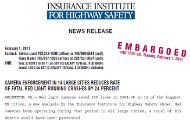Opinion: Insurance Institute Traffic Camera Study Flawed
The automated enforcement industry has suffered significant setbacks in the past several months. In November, voters in America’s fourth largest city, Houston, Texas, used the referendum process to outlaw automated ticketing machines. A number of California cities have been dropping red light camera programs after experiencing mediocre safety results. Now one of the key industry players, the Insurance Institute for Highway Safety (IIHS), is fighting back with a report released today claiming that with more red light cameras “a total of 815 deaths could have been avoided.” The IIHS report, however, did not actually consider a single red light camera accident.
Instead, the Insurance Institute looked at the raw number of intersection fatalities in 62 large US cities and divided them into a group of 14 localities where red light cameras were installed and a group of 48 camera-free cities. For each group, accidents in the “before” period of 1992 to 1996 were compared with an “after” period of 2004 to 2008. IIHS claimed that fatal “red light” crashes (defined as any intersection crash except a rear end collision) dropped 35 percent in the after period for the cities that happened to have cameras but only dropped 14 percent in the after period. The results reflect citywide accident numbers, not figures at photo enforced locations.
The problem with this overly simplistic method is that it credits red light cameras with accident reductions that take place at intersections without any cameras. It also ignores the natural reduction in fatality rates that happens as automobiles become more crashworthy and hospital trauma care improves over time. Overall, between 1992 and 2008, the fatality rate nationwide dropped 28 percent. The rate is down 35 percent in 2009, representing the lowest rate since records were first kept in 1950.
A more complete analysis of fatal accidents performed by the National Highway Traffic Safety Administration concluded that “large fatality declines tended to coincide with areas that had higher increases in rates of unemployment” ( view report). This is the case because unemployment takes drivers off the road in peak travel times reducing the chances of an accident. Many of the hardest hit areas economically have turned to automated enforcement to increase revenue. Moreover, studies conducted by independent researchers examining actual accident reports have found that accidents and injuries tend to increase where cameras are used ( view reports). This is one of the reasons the public has turned against cameras, a fact that the industry attempts to deny.
“National surveys indicate widespread support for red light cameras,” the insurance industry press release claimed. “At the same time, opponents of automated enforcement have become increasingly vocal, claiming that camera programs are revenue-generating schemes.”
This assertion emphasizes the IIHS report’s lack of objectivity. It is impossible to claim “widespread” support for a program that has been rejected at the ballot box in fifteen out of fifteen elections. The mix of cities that rejected cameras encompass East coast, West coast, liberal, conservative, small and large demographic groups. The anti-camera vote frequently reached between 60 and 86 percent.
The skewed results are not surprising considering the direct financial interest IIHS has in expanding the use of traffic cameras. The Insurance Institute represents the interests of all the major automobile insurance firms from AAA and Geico to State Farm and Allstate. The organization describes its mission as “highway safety research and communications” with the latter mission referring to public relations. Each time a photo ticket is issued in California, Arizona or Illinois (freeway program only), points are assigned to the license of the vehicle owner. Those points give insurance companies the ability to raise the rates for the ticket recipient by anywhere from $50 a year to $500 or more. Since the extra premium does not reflect any additional service rendered, it adds hundreds of millions to the industry’s bottom line each year.
[Courtesy: Thenewspaper.com]
More by The Newspaper
Latest Car Reviews
Read moreLatest Product Reviews
Read moreRecent Comments
- Brian Uchida Laguna Seca, corkscrew, (drying track off in rental car prior to Superbike test session), at speed - turn 9 big Willow Springs racing a motorcycle,- at greater speed (but riding shotgun) - The Carrousel at Sears Point in a 1981 PA9 Osella 2 litre FIA racer with Eddie Lawson at the wheel! (apologies for not being brief!)
- Mister It wasn't helped any by the horrible fuel economy for what it was... something like 22mpg city, iirc.
- Lorenzo I shop for all-season tires that have good wet and dry pavement grip and use them year-round. Nothing works on black ice, and I stopped driving in snow long ago - I'll wait until the streets and highways are plowed, when all-seasons are good enough. After all, I don't live in Canada or deep in the snow zone.
- FormerFF I’m in Atlanta. The summers go on in April and come off in October. I have a Cayman that stays on summer tires year round and gets driven on winter days when the temperature gets above 45 F and it’s dry, which is usually at least once a week.
- Kwik_Shift_Pro4X I've never driven anything that would justify having summer tires.


































Comments
Join the conversation
Shocker. The IIHS does crash tests and surveys to build credibility for the organization, and then the organizations backer's spend that credibility when it actually matters to their bottom line. In this case, spreading the use of camera enforcement, and down the road assigning points to the licenses of as many citizens as possible. And it's not like the insurance companies would really care if the IIHS' name got trashed in the process. They'd simply rename the organization and re-invest in establishing it as a trusted nameplate. This is why, when anyone quotes and IIHS finding on basically any topic, I say "don't do that." They simply have too much skin in the game. And to all the crash test defenders out there...how would you feel if this was a pharmaceutical industry article?
Steve65, didn't mean to sound patronizing. Legitimately, a lot of places don't have yield signs any more. It's a disappearing concept. Sorry it came out like that. Neither running a red light at 2am on an empty road nor turning right on red at low speeds should be ticketed. I don't believe in ticketing behavior unless it's actually dangerous. Sort of like how California speed laws used to say "reasonable and prudent" -- so the cop would have to prove that your driving 40 mph in a 35 zone was dangerous. Same thing should be applied to intersection tickets. More people die every year from paper cut wounds than from people making slow, rolling rights on red.